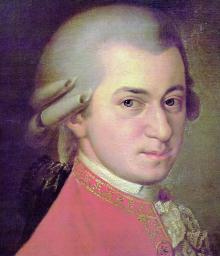
o

Viotti/Mozart cdc 010 |
Mozart was an artist in the fullest sense of the term. Both dissolute and a genius he was able to reconcile opposites: the objective and the subjective, artistic purity and human reality, the levity of melodies and depth of thought, the absolute and the relative. He passed easily from comic music which was apparently shallow to music of much greater complexity and of great artistic merit. For Mozart every musical form was an opportunity for the experience of inspiration and amusement. He could do everything and he did everything well. He was an organist, a pianist, a harpsichord player, a violinist, a conductor - |
Chronology:
| 1756 | Born (27 January) in Salzburg, the son of Johann Leopold and Anna Maria Pertl (1720-78). |
| 1761 | First composition - a minuet and trio for pianoforte. |
| 1763 | Goes to Paris where he stays for five months. His first sonatas for violin and pianoforte. |
| 1764 | Goes to London where he stays for fifteen months. He meets Karl Friedrich Abel and Johann Christian Bach. He writes his first symphony (E flat major K16). |
| 1769 | On 14 November he is appointed third maestro of concerts (unpaid) at the Salzburg court. In December he starts on the first of his three trips to Italy. In Rome he receives the order of the "Sperone d'Oro" from Pope XIV in person. |
| 1770 | On 5 January he performs his first concert in Italy at the Accademia Filarmonica of Vienna. He receives lessons in counterpoint from Padre Martini. Giuseppe Tartini dies on 26 February. Beethoven is born on 17 December. |
| 1778 | On 3 July his mother dies. In December the Teatro della Scala in Milan opens in Milan. |
| 1779 | The singer Aloisa Weber rejects his offer of marriage. He returns to Vienna and enters the service of the Archbishop of that city as maestro of concerts and court organist. |
| 1781 | On 10 May he resigns his post with the Archbishop. |
| 1782 | Marries Constanze Weber after eloping with her because of her father's strong opposition. On 27 October Nicoḷ Paganini is born. |
| 1783 | He meets Gluck. |
| 1785 | A very active professional life with concerts and activity in musical academies. He becomes a "companion" - the second rung in the order of freemasons. He meets Haydn. Refused admission to the Society of Musicians. |
| 1786 | Finishes "Le Nozze di Figaro" which is then performed at the Burgtheater on 1 May. |
| 1787 | On 28 May Leopold Mozart dies aged sixty-eight. On 29 October "Il Dissoluto Punito Ossia il Don Giovanni" is performed for the first time, in Prague, and is received with enthusiasm. |
| 1790 | On 26 January "Cosi fan Tutte Ossia la Scuola degli Amanti" is put on for the first time, at the Burgtheater. Mozart's financial problems worsen. |
| 1791 | He performs for the last time in public - the concerto for pianoforte K595. In May he begins work on "Die Zauberflote" (The Magic Flute) a German opera which in July he interrupts to write "La Clemenza di Tito", a work which he finishes on 5 September and which is performed in Prague the next day. In September he finishes "Die Zauberflote". On 20 November he falls ill and is confined to bed. On 4 December he tries out his "Requiem" - a work he would never complete. On 5 December he dies at one o'clock in the morning. His funeral is that of a poor man and is attended by a few close relatives and friends. His coffin is placed in the common grave at the cemetery of S. Marco in Vienna. |
![]()
©
P&P - Promozione e Produzione, Rome.